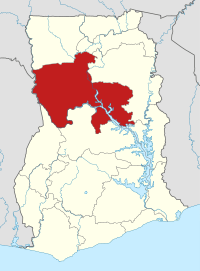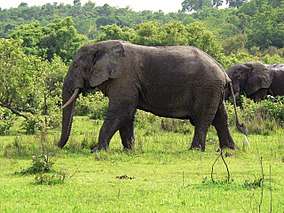Savannah Region
The Savannah Region is one of the newest regions of Ghana and yet the largest region in the country. The creation of the Region follows presentation of a petition by the Gonja Traditional Council, led by the Yagbonwura Tumtumba Boresa Jakpa I. Upon receiving favourable responses from all stakeholders in the Northern Region (the region it was broken off from), the Brobbey Commission (the Commission tasked with the creation of the new regions), a referendum was conducted on the 27th December 2018. The result was a resounding yes of 99.7%. The President of the Republic of Ghana signed and presented the Constitutional Instrument (CI) 115 to the Yagbonwura in the Jubilee House, Accra on the 12th of February, 2019. The launch was well attended by sons and daughters of Gonjaland including all current and past Mps, MDCEs and all appointees with Gonjaland descent. Damongo was declared the capital of the new Savannah Region. It is located in the north of the country. The Savannah Region is divided into 7 districts; Bole, Central Gonja, North Gonja, East Gonja, Sawla/Tuna/Kalba, West Gonja, North East Gonja and 7 Constituencies; Bole/Bamboi, Damongo, Daboya/Mankarigu, Salaga North, Salaga South, Sawla/Tuna/Kalba and Yapei/Kusawgu.[5][6]
Savannah Region | |
|---|---|
Larabanga Mosque, one of the oldest mosques in West Africa (bar those in Mali, Senegal etc.) | |
 Location of Savannah Region in Ghana | |
| Country | Ghana |
| Capital | Damongo |
| Districts | 6 |
| Area | |
| • Total | 35,862 km2 (13,846 sq mi) |
| Population (2010 Census)[3] | |
| • Total | 581,368[4] |
| Time zone | GMT |
| Area code(s) | 037 |
| ISO 3166 code | GH-NP |
History
A referendum on 27 December 2018[7] approved the creation of Savannah Region, with 206,350 (99.52%) votes in favour on a turnout of 81.77%.[8][9][10] CI 115 establishing the Region signed and presented on 12 February 2019.[11]
Geography and climate
Location and size
The Savannah Region is bordered on the north by the Upper West region, on the west by the Ghana-Côte d'Ivoire international border, on the south by the Bono and Bono East regions, and on the west by the North East and Northern regions. Savannah region is made up of 7 districts.
Climate and vegetation
The Savannah Region is much drier than southern areas of Ghana, due to its proximity to the Sahel, and the Sahara. The vegetation consists predominantly of grassland, especially savanna with clusters of drought-resistant trees such as baobabs or acacias. Between December and April is the dry season. The wet season is between about July and November with an average annual rainfall of 750 to 1050 mm (30 to 40 inches). The highest temperatures are reached at the end of the dry season, the lowest in December and January. However, the hot Harmattan wind from the Sahara blows frequently between December and the beginning of February. The temperatures can vary between 14 °C (59 °F) at night and 40 °C (104 °F) during the day.
Tourism & Parks
- Mole National Park
- Bui National Park[12] (now defunct due to Bui National Dam)
- Larabanga Historic Mosque[13]
- Wechiau Hippo Sanctuary[14]
Demographics
The Savannah Region has a low population density, and, along with the official language of English, most inhabitants speak a language of the Oti–Volta subfamily in the Niger–Congo language family, such as Gonja, Dagbani, Mamprusi, or Tamprusi.
Religion
A majority of residents in the Savanna Region identify as Muslim.[15]
Districts
.png)
The Savannah Region of Ghana contains 7 districts.[16]
| Districts in Savannah region | |||
|---|---|---|---|
| # | District | Capital | Population |
| 1 | Bole | Bole | |
| 2 | Central Gonja | Buipe | |
| 3 | North Gonja | Daboya | |
| 4 | East Gonja | Salaga | |
| 5 | North East Gonja | Kpalbe | |
| 6 | West Gonja | Damongo | |
| 7 | Sawla-Tuna-Kalba | Sawla | |
Famous citizens
| # | Citizen | Settlement |
|---|---|---|
| 1 | John Dramani Mahama | Bole |
References
- "Northern Region". GhanaDistricts.com. Retrieved 2009-11-20.
- "Ghana Districts: A repository of all Local Assemblies in Ghana". GhanaDistricts.com. Retrieved 2019-02-12.
- "Northern Region – Population" (PDF). statsghana.gov.gh. Retrieved 2013-01-20.
- http://www.ghanadistricts.com/Home/Region/14
- Zoure, Stephen (27 December 2018). "Mahama votes in referendum for proposed Savannah Region in Bole". MyNewsGH. Retrieved 28 December 2018.
- "'Savannah will soon catch-up with other regions' - Akufo-Addo assures". Citi Newsroom. 2019-05-20. Retrieved 2019-05-20.
- "Referendum: Massive YES votes for 6 new regions | General News 2018-12-28". www.ghanaweb.com. Retrieved 2019-01-02.
- "All six proposed regions meet constitutional threshold requirements – EC". Ghana Business News. 29 December 2018.
- Zurek, Kweku (2018-12-28). "CONFIRMED: Results of the 2018 Referendum on new regions". Graphic Online. Retrieved 2019-01-02.
- "Referendum: 6 new regions get massive 'YES' votes". www.pulse.com.gh. 2018-12-28. Retrieved 2019-01-02.
- "Savannah Region will benefit from her natural resource deposits – Akufo-Addo".
- "Bui National Park". Ghana Wildlife Division. Retrieved 23 April 2018.
- Haun, William (2018-07-24). "Ghana's Historic Mosques: Larabanga". Hauns in Africa. Retrieved 28 December 2018.
- Haun, William (2018-05-11). "Visiting the Wechiau Hippo Sanctuary". Hauns in Africa. Retrieved 28 December 2018.
- Table 4.17: Population by religious affiliation and region, 2010
- "Northern". GhanaDistricts.com. Archived from the original on 18 January 2013. Retrieved 15 January 2013.
- "Districts of Ghana". Statoids.
- GhanaDistricts.com
